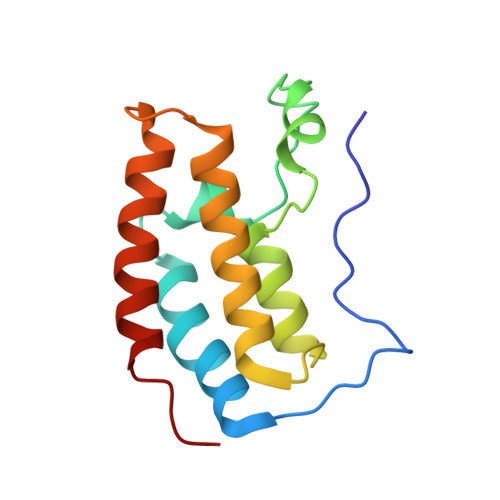Structure-Guided Design of a Domain-Selective Bromodomain and Extra Terminal N-Terminal Bromodomain Chemical Probe.
Bradley, E., Fusani, L., Chung, C.W., Craggs, P.D., Demont, E.H., Humphreys, P.G., Mitchell, D.J., Phillipou, A., Rioja, I., Shah, R.R., Wellaway, C.R., Prinjha, R.K., Palmer, D.S., Kerr, W.J., Reid, M., Wall, I.D., Cookson, R.(2023) J Med Chem 66: 15728-15749
- PubMed: 37967462
- DOI: https://doi.org/10.1021/acs.jmedchem.3c00906
- Primary Citation of Related Structures:
8PX2, 8PX8, 8PXA - PubMed Abstract:
Small-molecule-mediated disruption of the protein-protein interactions between acetylated histone tails and the tandem bromodomains of the bromodomain and extra-terminal (BET) family of proteins is an important mechanism of action for the potential modulation of immuno-inflammatory and oncology disease. High-quality chemical probes have proven invaluable in elucidating profound BET bromodomain biology, with seminal publications of both pan- and domain-selective BET family bromodomain inhibitors enabling academic and industrial research. To enrich the toolbox of structurally differentiated N-terminal bromodomain (BD1) BET family chemical probes, this work describes an analysis of the GSK BRD4 bromodomain data set through a lipophilic efficiency lens, which enabled identification of a BD1 domain-biased benzimidazole series. Structure-guided growth targeting a key Asp/His BD1/BD2 switch enabled delivery of GSK023, a high-quality chemical probe with 300-1000-fold BET BD1 domain selectivity and a phenotypic cellular fingerprint consistent with BET bromodomain inhibition.
Organizational Affiliation:
GSK, Medicines Research Centre, Stevenage SG1 2NY, Hertfordshire, U.K.

















